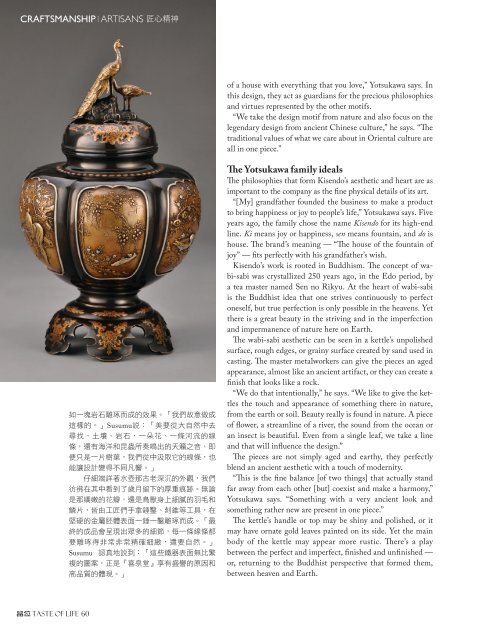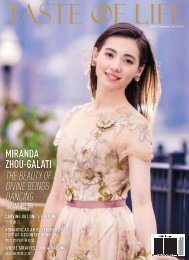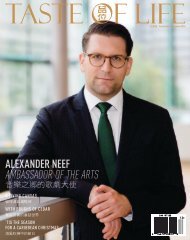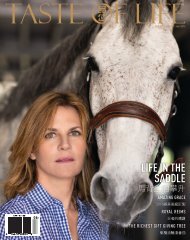You also want an ePaper? Increase the reach of your titles
YUMPU automatically turns print PDFs into web optimized ePapers that Google loves.
CRAFTSMANSHIP | ARTISANS 匠 心 精 神<br />
如 一 塊 岩 石 雕 琢 而 成 的 效 果 。「 我 們 故 意 做 成<br />
這 樣 的 。」Susumu 說 :「 美 要 從 大 自 然 中 去<br />
尋 找 , 土 壤 、 岩 石 , 一 朵 花 、 一 條 河 流 的 線<br />
條 , 還 有 海 洋 和 昆 蟲 所 奏 鳴 出 的 天 籟 之 音 , 即<br />
便 只 是 一 片 樹 葉 , 我 們 從 中 汲 取 它 的 線 條 , 也<br />
能 讓 設 計 變 得 不 同 凡 響 。」<br />
仔 細 端 詳 著 水 壺 那 古 老 深 沉 的 外 觀 , 我 們<br />
彷 彿 在 其 中 看 到 了 歲 月 留 下 的 厚 重 痕 跡 。 無 論<br />
是 那 嬌 嫩 的 花 瓣 , 還 是 鳥 獸 身 上 細 膩 的 羽 毛 和<br />
鱗 片 , 皆 由 工 匠 們 手 拿 錘 鑿 、 刻 錐 等 工 具 , 在<br />
堅 硬 的 金 屬 胚 體 表 面 一 錘 一 鑿 雕 琢 而 成 。「 最<br />
終 的 成 品 會 呈 現 出 眾 多 的 細 節 , 每 一 條 線 條 都<br />
要 雕 琢 得 非 常 非 常 精 確 細 緻 , 還 要 自 然 。」<br />
Susumu 認 真 地 說 到 :「 這 些 鐵 器 表 面 無 比 繁<br />
複 的 圖 案 , 正 是 『 喜 泉 堂 』 享 有 盛 譽 的 原 因 和<br />
高 品 質 的 體 現 。」<br />
of a house with everything that you love,” Yotsukawa says. In<br />
this design, they act as guardians for the precious philosophies<br />
and virtues represented by the other motifs.<br />
“We take the design motif from nature and also focus on the<br />
legendary design from ancient Chinese culture,” he says. “The<br />
traditional values of what we care about in Oriental culture are<br />
all in one piece.”<br />
The Yotsukawa family ideals<br />
The philosophies that form Kisendo’s aesthetic and heart are as<br />
important to the company as the fine physical details of its art.<br />
“[My] grandfather founded the business to make a product<br />
to bring happiness or joy to people’s life,” Yotsukawa says. Five<br />
years ago, the family chose the name Kisendo for its high-end<br />
line. Ki means joy or happiness, sen means fountain, and do is<br />
house. The brand’s meaning — “The house of the fountain of<br />
joy” — fits perfectly with his grandfather’s wish.<br />
Kisendo’s work is rooted in Buddhism. The concept of wabi-sabi<br />
was crystallized 250 years ago, in the Edo period, by<br />
a tea master named Sen no Rikyu. At the heart of wabi-sabi<br />
is the Buddhist idea that one strives continuously to perfect<br />
oneself, but true perfection is only possible in the heavens. Yet<br />
there is a great beauty in the striving and in the imperfection<br />
and impermanence of nature here on Earth.<br />
The wabi-sabi aesthetic can be seen in a kettle’s unpolished<br />
surface, rough edges, or grainy surface created by sand used in<br />
casting. The master metalworkers can give the pieces an aged<br />
appearance, almost like an ancient artifact, or they can create a<br />
finish that looks like a rock.<br />
“We do that intentionally,” he says. “We like to give the kettles<br />
the touch and appearance of something there in nature,<br />
from the earth or soil. Beauty really is found in nature. A piece<br />
of flower, a streamline of a river, the sound from the ocean or<br />
an insect is beautiful. Even from a single leaf, we take a line<br />
and that will influence the design.”<br />
The pieces are not simply aged and earthy, they perfectly<br />
blend an ancient aesthetic with a touch of modernity.<br />
“This is the fine balance [of two things] that actually stand<br />
far away from each other [but] coexist and make a harmony,”<br />
Yotsukawa says. “Something with a very ancient look and<br />
something rather new are present in one piece.”<br />
The kettle’s handle or top may be shiny and polished, or it<br />
may have ornate gold leaves painted on its side. Yet the main<br />
body of the kettle may appear more rustic. There’s a play<br />
between the perfect and imperfect, finished and unfinished —<br />
or, returning to the Buddhist perspective that formed them,<br />
between heaven and Earth.<br />
How It’s Made<br />
We peek inside the workshops that form<br />
Kisendo’s kettles and incense burners.<br />
English Text by Kristen Meriwether<br />
Translated by Zhao Wen<br />
一 探 究 竟<br />
經 過 特 別 的 許 可 ,《 品 位 》 難 得 前 往<br />
「 喜 泉 堂 」 工 坊 , 參 觀 了 其 鑄 造 水 壺 和 香 爐<br />
的 全 過 程 , 下 面 就 與 大 家 分 享 一 下 一 件 精 美<br />
「 喜 泉 堂 」 鑄 造 器 的 誕 生 過 程 。<br />
首 先 使 用 粘 土 或 木 材 等 易 於 塑 造 的 材<br />
質 來 製 作 水 壺 或 香 爐 的 模 型 。 手 藝 高 超 的 工<br />
匠 在 此 步 驟 便 會 將 器 皿 上 的 花 卉 或 動 物 圖 案<br />
雕 琢 得 精 美 準 確 , 這 樣 才 能 確 保 最 終 的 成 品<br />
達 到 水 準 。 模 型 完 成 後 , 工 匠 將 融 化 的 矽 膠<br />
均 勻 地 附 著 在 它 的 表 面 。 待 矽 膠 冷 卻 後 , 將<br />
其 取 下 得 到 一 個 模 具 。 把 石 膏 漿 塗 在 矽 膠 模<br />
具 表 面 , 等 外 層 的 石 膏 漿 如 水 泥 般 凝 固 變 硬<br />
後 , 內 部 軟 軟 的 矽 膠 模 具 會 被 支 撐 起 來 。 當<br />
器 皿 的 器 形 很 複 雜 時 , 工 匠 們 可 能 將 一 件 器<br />
皿 分 成 數 個 部 份 , 分 別 使 用 上 述 工 藝 , 做 成<br />
一 個 個 這 樣 的 石 膏 矽 膠 雙 層 模 型 。<br />
1<br />
然 後 將 融 化 的 蠟 液 注 入 到 矽 膠 模 型<br />
中 , 蠟 液 凝 固 後 , 除 去 外 層 的 石 膏 和 矽 膠 模<br />
具 , 得 到 一 個 蠟 質 的 器 皿 的 模 型 。<br />
2<br />
工 匠 使 用 加 熱 工 具 對 蠟 質 模 具 進 行 細<br />
緻 修 整 , 同 時 會 為 模 型 添 加 一 個 蠟 質 的 吸 管<br />
樣 的 澆 鑄 口 , 燒 熔 化 的 金 屬 汁 之 後 便 從 這 個<br />
通 道 注 入 到 模 具 中 。<br />
3<br />
將 修 整 好 的 蠟 質 模 型 反 覆 浸 入 到 類 似<br />
水 泥 的 耐 熱 砂 漿 中 , 在 表 面 形 成 厚 殼 。 4<br />
待 耐 熱 砂 漿 凝 固 後 , 接 下 來 的 步 驟 正<br />
是 這 種 鑄 造 方 法 被 命 名 為 「 失 蠟 法 」 的 原<br />
因 。 這 種 工 藝 最 早 可 追 溯 至 公 元 前 3,000 年<br />
左 右 , 在 世 界 各 地 都 被 廣 泛 使 用 。 直 至 今<br />
日 ,「 失 蠟 法 」 的 核 心 工 藝 依 然 沒 有 發 生 太<br />
大 變 化 , 還 被 運 用 在 許 多 高 精 密 機 械 部 件 的<br />
製 造 上 。 將 耐 熱 砂 漿 硬 殼 加 熱 , 讓 裏 面 的 蠟<br />
模 融 化 , 然 後 把 蠟 汁 倒 出 。<br />
5<br />
澆 鑄 工 匠 將 燒 熔 化 的 銅 鐵 混 合 液 體 ,<br />
從 剛 才 預 留 出 的 澆 鑄 口 注 入 到 耐 熱 砂 模 。 通<br />
常 需 要 放 置 整 整 一 夜 , 裏 面 的 金 屬 熔 液 才 會<br />
完 全 冷 卻 變 硬 。<br />
6<br />
冷 卻 後 , 工 匠 們 用 錘 子 小 心 敲 打 砂 模 ,<br />
讓 其 碎 裂 掉 落 。 再 將 澆 鑄 口 部 分 多 出 來 金 屬<br />
切 掉 , 讓 鑄 件 表 面 儘 量 平 整 如 模 型 。<br />
7<br />
手 藝 高 超 的 金 屬 工 匠 開 始 對 鑄 造 好 的<br />
金 屬 坯 件 進 行 精 細 修 整 和 雕 琢 。 有 些 壺 和 香<br />
爐 表 面 的 複 雜 花 卉 或 鳥 獸 、 山 水 裝 飾 是 後 來<br />
焊 接 上 去 的 , 有 時 還 需 要 點 綴 上 華 麗 的 鍍 金<br />
層 。 最 後 , 工 匠 們 會 對 整 件 鐵 壺 和 香 爐 進 行<br />
拋 光 和 使 用 一 些 天 然 礦 物 質 進 行 繪 製 。 8<br />
1<br />
2<br />
3<br />
4<br />
5<br />
6<br />
7<br />
First, a kettle or incense burner is designed<br />
by sculpting or carving it out of clay or<br />
wood. Creating this master model is the<br />
most important step in determining the look<br />
of the finished product. The master craftsman<br />
painstakingly fine-tunes each flower<br />
petal, animal, or pattern to ensure they are<br />
clear in the final piece.<br />
Once the model is complete, it is covered<br />
in silicone, which creates the first of several<br />
different moulds needed throughout the<br />
creation process. Plaster is then spread over<br />
the silicone mould and left to dry, so the soft<br />
silicone mould is supported by the hard plaster.<br />
Both moulds are usually cut down the middle,<br />
dividing them into two halves. But in very<br />
complex designs, they are sometimes broken<br />
down further into several pieces.<br />
Next, liquid wax is poured inside the<br />
moulds. After the wax hardens, it is removed,<br />
producing a copy of the original model.<br />
An artisan uses a heated precision tool to<br />
make any needed refinements to the wax copy.<br />
Then he attaches long pieces of wax to it, shaped<br />
like drinking straws, called spruing.<br />
The wax copy is dipped repeatedly into a<br />
fine sandy slurry (something like cement)<br />
that is heat-resistant.<br />
This slurry hardens into a shell around the<br />
wax copy. The next step gives this ancient<br />
technique its name, “lost-wax casting.” The<br />
method dates from around 3,000 B.C. and<br />
has been used by cultures all over the world.<br />
It is used not only by artisans, but also in<br />
industry to create propellers and other mechanical<br />
parts that require great precision.<br />
The sandy shell is fired, which melts the wax<br />
(the wax is thus “lost”).<br />
When melted away, the spruing sticking<br />
out of the sandy shell provides conduits for<br />
the wax to pour out and for molten metal<br />
to be poured in. A metalworker then pours<br />
in copper or iron that has been heated to<br />
600°F. It hardens as it cools overnight into<br />
the shape of the wax model.<br />
The artisans break away the sandy shell<br />
with a hammer and cut away the spruing.<br />
They then repair the places where the spruing<br />
was attached.<br />
A master metal artisan refines the minute<br />
patterns with chisels and finishing tools.<br />
This requires immense patience, but allows<br />
the artisan to highlight his or her skill level.<br />
Some ornamental parts, such as tiny animals,<br />
people, or objects, are made separately and<br />
welded onto the piece. The work of art may<br />
then be painted and polished. The paints are<br />
created with natural minerals.<br />
1<br />
2<br />
3<br />
4<br />
5<br />
6<br />
7<br />
8<br />
60<br />
8









